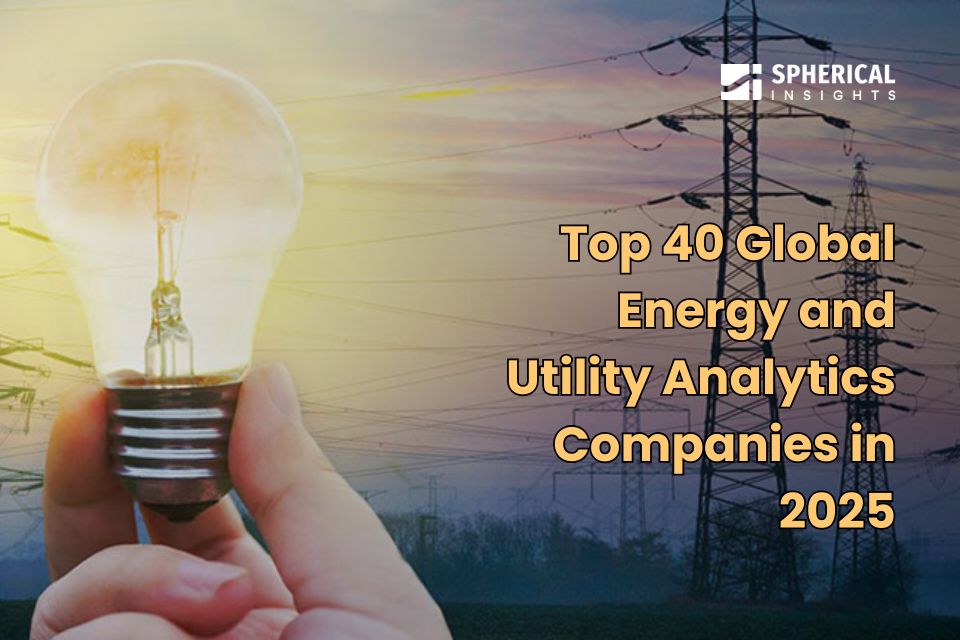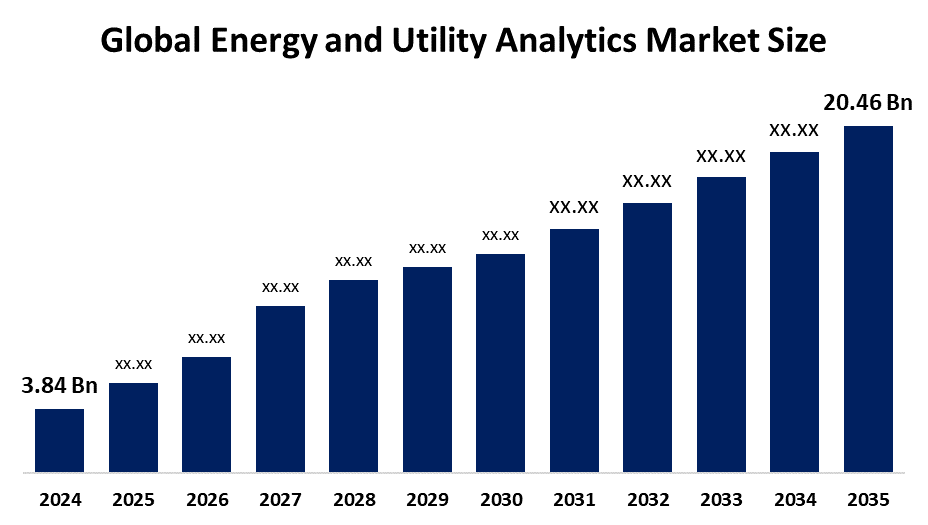
Top 40 Global Energy and Utility Analytics Companies in 2025: Market Intelligence and Investment Trends (2024–2035)
RELEASE DATE: Aug 2025 Author: Spherical InsightsRequest Free Sample Speak to Analyst
Description
According to a research report published by Spherical Insights & Consulting, The Global Energy and Utility Analytics Market Size is projected to Grow from USD 3.84 Billion in 2024 to USD 20.46 Billion by 2035, at a CAGR of 16.43% during the forecast period 2025–2035. The need for effective energy management and cost reduction, the growing deployment of smart grids and IoT sensors, the government's emphasis on smart meters, and the growing usage of AI and machine learning are all important growth factors.
Introduction
Energy and utility analytics are the act of collecting, analysing, and visualising energy data in order to gain insights that might help energy and utility firms improve their business performance. Analytics can improve customer service and give timely input on power outages, infrastructure weaknesses, and crew status. Artificial intelligence, machine learning, and statistics are used in energy and utility analytics to track and optimise energy use across distribution and generation facilities. By comparing consumption patterns across units, these analytics improve power distribution efficiency, forecast business trends, control expenses, and stop revenue loss from energy theft. To increase system flexibility and dependability, projects like MAPLE LEAF and MAPLE BRANCH investigate cutting-edge approaches, including under-frequency load shedding and grid-friendly inverter behaviours. Even with improvements, there is still a considerable gap in the integration of big data platforms and cloud computing. Smarter energy management is made possible by the emergence of intelligent grid technologies, which allow for centralised control, monitoring, and analysis. The demand for advanced analytics is being pushed by governments' emphasis on smart meters and AI-based data analysis, which will help utilities better forecast usage and optimise electricity distribution. Enhancing operational efficiency through the integration of IoT sensors, SCADA, and intelligent systems presents a substantial development opportunity in the energy and utilities sector.
Navigate Future Markets with Confidence: Insights from Spherical Insights LLP
The insights presented in this blog are derived from comprehensive market research conducted by Spherical Insights LLP, a trusted advisory partner to leading global enterprises. Backed by in-depth data analysis, expert forecasting, and industry-specific intelligence, our reports empower decision-makers to identify strategic growth opportunities in fast-evolving sectors. Clients seeking detailed market segmentation, competitive landscapes, regional outlooks, and future investment trends will find immense value in the full report. By leveraging our research, businesses can make informed decisions, gain a competitive edge, and stay ahead in the transition toward sustainable and profitable solutions.
Unlock exclusive market insights-Download the Brochure now and dive deeper into the future of the Energy and Utility Analytics Market.
Energy and Utility Analytics Market Size & Statistics
- The Market Size for Energy and Utility Analytics Was Estimated to be worth USD 3.84 Billion in 2024.
- The Market Size is Going to Expand at a CAGR of 16.43% between 2025 and 2035.
- The Global Energy and Utility Analytics Market Size is anticipated to reach USD 20.46 Billion by 2035.
- North America is expected to generate the highest demand during the forecast period in the Energy and Utility Analytics Market
- Europe is expected to grow the fastest during the forecast period in the Energy and Utility Analytics Market.

Regional growth and demand
Europe is expected to grow the fastest during the forecast period in the energy and utility analytics market. The region's strong commitment to sustainability and renewable energy initiatives is the reason for the quick expansion. European governments are implementing policies that encourage the use of sophisticated analytics to reduce greenhouse gas emissions and optimise energy use. Furthermore, the increasing use of smart meters and grid technologies facilitates the collection and analysis of real-time data, enabling utilities to make more informed decisions. The rapid expansion in this field is also attributed to the rise in both established companies and innovative startups focusing on energy analytics. Europe's market is expected to rise significantly as more people become aware of the benefits of analytical solutions.
North America is expected to generate the highest demand during the forecast period in the energy and utility analytics market. The region's dominance is a result of its substantial investments in offshore oil and gas exploration as well as its sophisticated energy infrastructure. The existence of significant industry players and a heightened emphasis on enhancing energy efficiency are additional factors propelling market expansion. Strict laws about environmental and safety protection require the use of premium thermal insulation materials. Technological developments in the area are also very important for subsea operations; creative insulation solutions are being used more and more to improve efficiency and cut expenses. North America is therefore in a strong position to dominate the market for energy and utility analytics.
Top 10 trends in the Energy and Utility Analytics Market
- Integration of Artificial Intelligence and Machine Learning
- Deployment of Smart Grid Technologies
- Growth of IoT Sensors and Edge Computing
- Advanced Demand Forecasting and Load Management
- Cloud-Based Analytics Platforms
- Real-Time Energy Consumption Monitoring
- Enhanced Energy Theft Detection and Prevention
- Predictive Maintenance of Infrastructure
- Focus on Renewable Energy Analytics
- Regulatory Compliance and Cybersecurity Analytics
1. Integration of Artificial Intelligence and Machine Learning
In the energy and utility sectors, AI and ML provide sophisticated data analysis, pattern recognition, and predictive capabilities, which improve problem detection, energy optimisation, and demand forecasting. This results in more intelligent decision-making and increased operational efficiency.
2. Deployment of Smart Grid Technologies
Reducing outages and promoting sustainable energy management are the ultimate goals of smart grids, which employ digital communication and control technology to facilitate two-way energy flows, enhance grid dependability, integrate renewable energy sources, provide real-time monitoring, and distribute energy efficiently.
3. Growth of IoT Sensors and Edge Computing
While edge computing processes data locally, lowering latency and bandwidth, allowing for quicker response times and more effective grid management, IoT sensors gather real-time data on energy use and infrastructure health.
4. Advanced Demand Forecasting and Load Management
In order to improve grid stability and cost-effectiveness, advanced analytics forecast patterns of energy demand based on past data, weather, and consumption trends. This allows for better resource allocation, load distribution, and peak demand reduction.
5. Cloud-Based Analytics Platforms
Large volumes of energy data may be stored and analysed using cloud platforms' scalable and adaptable computing capabilities, which also make it easier to collaborate, lower IT expenses, and quickly implement analytics solutions across dispersed utility networks.
Empower your strategic planning:
Stay informed with the latest industry insights and market trends to identify new opportunities and drive growth in the energy and utility analytics market. To explore more in-depth trends, insights, and forecasts, please refer to our detailed report.
Top 13 Companies Leading the Energy and Utility Analytics Market
- Infor
- Microsoft
- Eaton
- IBM
- SAP
- Intel
- GE
- Schneider Electric
- Siemens
- Cisco
- Oracle
- SAS Institute
- Others
1. Infor
Headquarters: New York City, New York, USA
Global enterprise software vendor Infor provides cloud solutions tailored to particular industries, such as sophisticated analytics for the utilities and energy sectors. Their technologies optimise asset performance, increase energy management, and boost operational efficiency by utilising AI, machine learning, and big data. Utilities can manage maintenance, forecast demand, keep an eye on usage, and guarantee regulatory compliance with the help of Infor's solutions. With scalable, integrated, and intuitive analytics products designed for complicated utility contexts, Infor facilitates the digital transformation of energy providers for a wide range of worldwide clients.
2. Microsoft
Headquarters: Redmond, Washington, USA
Leading global technology company Microsoft provides cloud-based analytics and artificial intelligence solutions specifically designed for the utilities and energy industries. Microsoft offers strong tools for demand forecasting, predictive maintenance, real-time monitoring, and data integration through its Azure platform. Their products facilitate improved cybersecurity, integration of renewable energy sources, and smart grid management. Microsoft helps utilities all over the world optimise energy use, boost operational effectiveness, and hasten the digital transition to resilient and sustainable energy systems by utilising AI and IoT capabilities.
3. Eaton
Headquarters: Dublin, Ireland
Eaton is a multinational power management firm that focuses on sophisticated analytics and energy-efficient solutions for the utility industry. Eaton offers data-driven software, IoT-enabled sensors, and smart grid solutions that improve grid reliability, optimise power distribution, and facilitate predictive maintenance. Their analytics tools assist utilities in tracking energy usage, identifying issues, and enhancing operational efficiency. Through innovation, intelligent infrastructure, and the integration of state-of-the-art analytics, Eaton, which serves customers globally, is dedicated to developing sustainable energy management.
4. IBM
Headquarters: Armonk, New York, USA
IBM is a world leader in technology and consulting, offering cloud, AI, and advanced analytics solutions to the utilities and energy industries. Demand forecasting, predictive maintenance, real-time monitoring, and grid optimisation are all made possible by IBM's Watson IoT and AI-powered systems. Their products facilitate improved cybersecurity, smart grid management, and the integration of renewable energy. IBM assists utilities in utilising machine learning and big data to boost operational effectiveness, cut expenses, and promote sustainable energy innovation globally.
5. SAP
Headquarters: Walldorf, Germany
SAP provides cloud solutions and extensive analytics specifically designed for the utilities and energy sectors. Their technologies optimise demand forecasting, energy trading, asset management, and regulatory compliance by integrating IoT, AI, and machine learning. With SAP's solutions, utilities can boost consumer engagement, increase operational efficiency, and facilitate the switch to renewable energy. SAP, which serves a wide range of international clients, propels digital transformation by enabling more intelligent, scalable analytics that enable more intelligent, sustainable energy management.
Are you ready to discover more about the Energy and Utility Analytics market?
The report provides an in-depth analysis of the leading companies operating in the global energy and utility analytics market. It includes a comparative assessment based on their product portfolios, business overviews, geographical footprint, strategic initiatives, market segment share, and SWOT analysis. Each company is profiled using a standardized format that includes:
Company Profiles
- Infor
- Business Overview
- Company Snapshot
- Products Overview
- Company Market Share Analysis
- Company Coverage Portfolio
- Financial Analysis
- Recent Developments
- Merger and Acquisitions
- SWOT Analysis
- Microsoft
- Eaton
- IBM
- SAP
- Intel
- GE
- Schneider Electric
- Siemens
- Cisco
- Oracle
- SAS Institute
- Others
Conclusion
The growing need for effective energy management, the deployment of smart grids, and the incorporation of cutting-edge technologies like artificial intelligence, the Internet of Things, and cloud computing, the market for energy and utility analytics is expand steadily and sustainably. These developments give utilities the capacity to improve grid stability, streamline operations, and facilitate the integration of renewable energy sources. Widespread acceptance is fuelled by growing digital change and regulatory demands, despite obstacles including infrastructure complexity and cybersecurity worries. With an emphasis on real-time information, predictive analytics, and sustainable energy solutions, the industry is well-positioned for future growth.
About the Spherical Insights & Consulting
Spherical Insights & Consulting is a market research and consulting firm which provides actionable market research study, quantitative forecasting and trends analysis provides forward-looking insight especially designed for decision makers and aids ROI.
Which is catering to different industry such as financial sectors, industrial sectors, government organizations, universities, non-profits and corporations. The company's mission is to work with businesses to achieve business objectives and maintain strategic improvements.
CONTACT US:
For More Information on Your Target Market, Please Contact Us Below:
Phone: +1 303 800 4326 (the U.S.)
Phone: +91 90289 24100 (APAC)
Email: inquiry@sphericalinsights.com, sales@sphericalinsights.com
Contact Us: https://www.sphericalinsights.com/contact-us
Need help to buy this report?